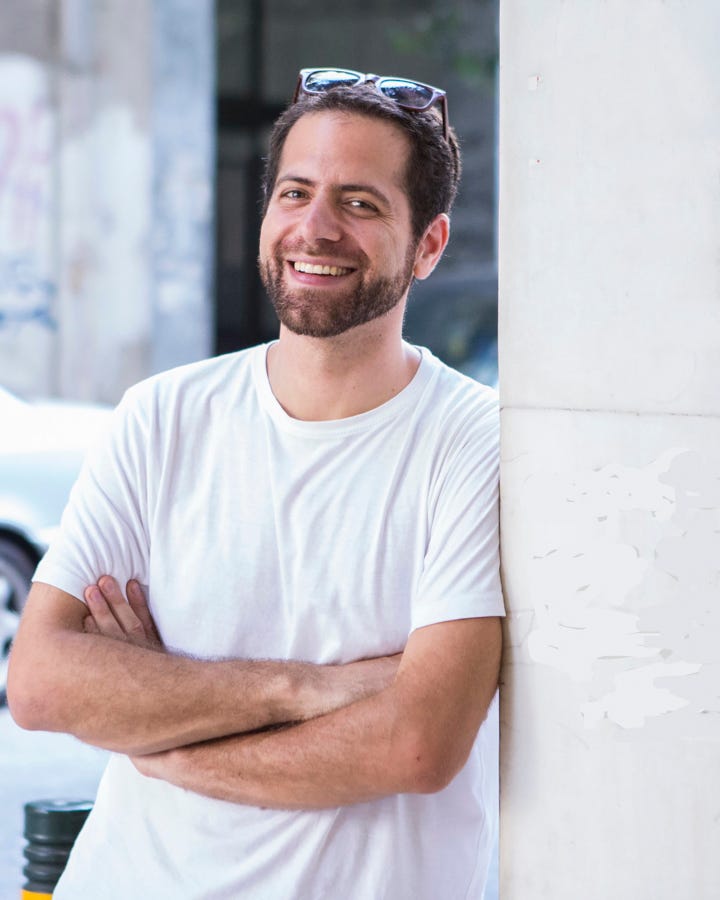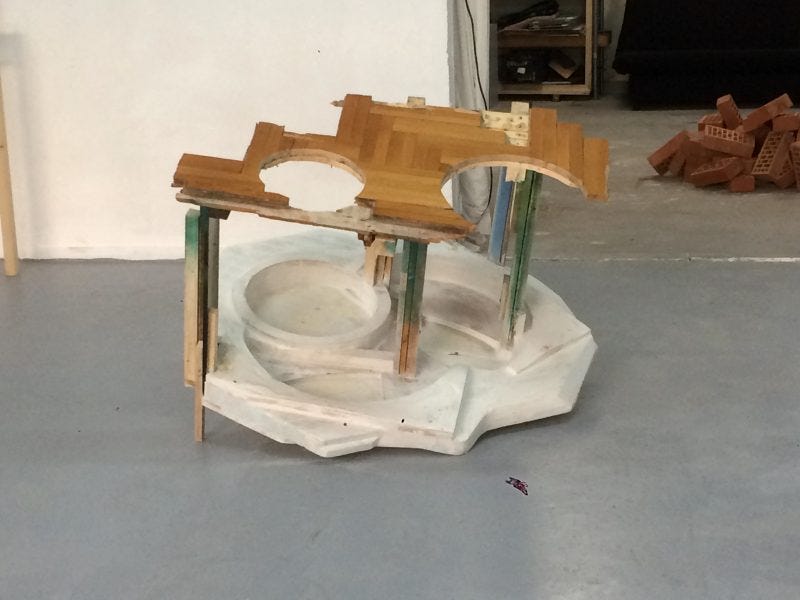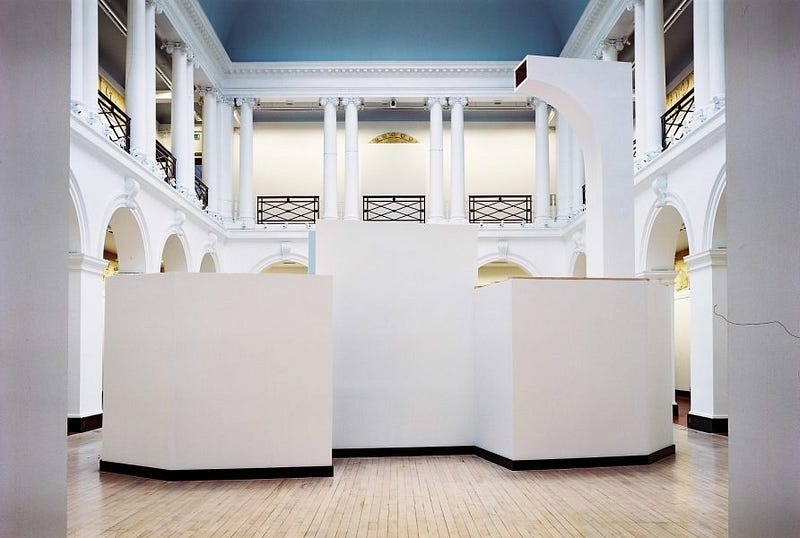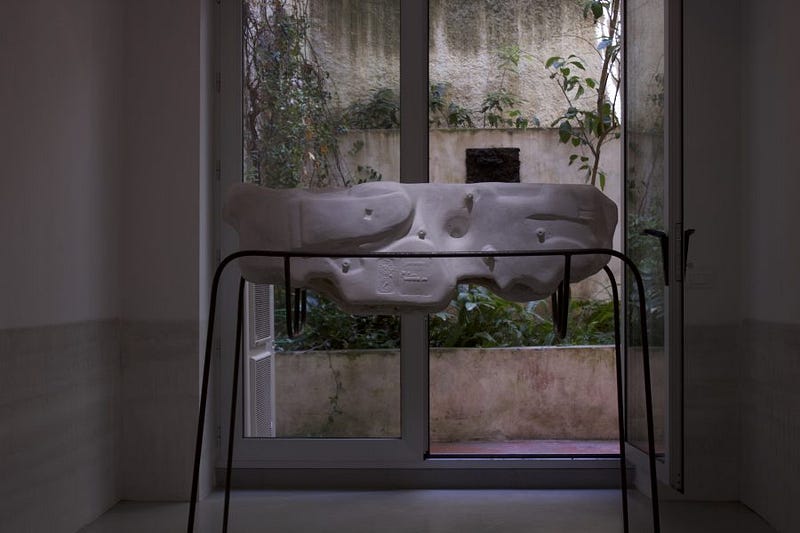15.11.2019
Augustus Veinoglou Giving Form and Breaking Bounds in Athens/Snehta
Εικαστικες Τεχνες
Γλώσσα πρωτότυπου κειμένου: Αγγλικά
Augustus Veinoglou is a man in demand. Before we were able to find a moment to sit down and talk, I tried no fewer than a half dozen times to schedule a meeting. The recurring phrase I heard in reply was “non-stop.” But when I did finally get a hold of him, I began to understand the cause of his elusiveness. If you imagine that any single artist has x number of concurrent plans, project sketches, fantasies, and crazy ideas running through their mind on a given day, then just think about managing the experience of three or four other artists at the same time. This is Augustus’ daily juggling routine: trying to maintain clarity and headspace for his own work while simultaneously helping to sustain Snehta, an Athens-based artist residency that he founded in 2012, which has plans to welcome 12 different visiting artists over the course of the upcoming year.

Augustus has the stamina, perhaps even a bit of the masochist’s pleasure, to drive the tempo of this treadmill of endless demands. But as we sit together at a bar and ease into a moment of early evening repose — with the promise of a few days of August holiday ahead — I can see Augustus settle in, briefly, to a different mode of being. He seems to appreciate the rare pause for self-reflection. As the various, interlocking logistical loops begin to relax, we turn our attention away from the hustle of Athens and Snehta, focusing on Augustus’ creative origins as a sculptor. We start within the confines of the artist’s studio, and then slowly rippling outward, arrive at a wider view of the city’s contemporary artistic landscape, touching on the most fundamental questions facing Athens’ artists today.
Augustus grew up in Athens and left promptly at the age of 18. He went to Scotland to study fine art for four years, focusing on sculpture. The rigor of art school was formative, and the approach he adopted for solving problems in the studio has stayed with him since. “Sculpture is a battle with matter,” he says. “It’s like being an athlete: you’re striving for a goal that is very hard to see when you begin. Instead, you just go back, day after day, trusting your persistence will bring you closer.” I had seen Augustus around the city many times over the previous months, most often at openings, enthusing about other people’s work. But now it becomes evident that he maintains a hidden reserve of energy for his own practice. He goes on, “When you have a studio full of materials, it is a messy space. In the midst of it, you are standing there, everything depending on your hands and your mind. At the start, it seems like a mythological labor — almost impossible. You forget that you have done this already. And then, suddenly, the reminiscence of those other 100 times gives you the courage to begin anew.”
The other important habit built up during art school was the balance between self-motivation and external critique. “What I learned in school was how to push a project until there are no other options. It’s easy to stop midway, but you know when you haven’t done the best you could do. For me, good art reveals that it went as far as it could. In London, some artists respond to critical feedback by saying, ‘Fuck your opinion, I’m more important than you.’ But I don’t support this position. I know when something works; there is a DNA understanding when ‘it’ is there. It’s a feeling in my whole body — and that belief will resonate with others.”

As we talk, it becomes evident how Augustus’ passions can be infectious, whether over a single work or an entire artistic program. But more deeply, I see that what drives all of Augustus’ efforts is a desire to draw structure out of chaos, coherency from entropy. He says, “Matter and ideas are really the same. To create shape, all you need is space and time. For example, when I’m working on Snehta, I need to have sketchbook time. I start by writing things down: a wood workshop, two interns, a gallery space, three artists. These are our materials. And then I begin putting them together in different arrangements, seeing what will resonate, and what new associations emerge.”
But I divert Augustus back to his early formation as an artist, before Snehta had come into being; its institutional structure was still a long way off. After finishing his BA, Augustus went on a trip to Italy. This turned out to be key to his creative perspective. Little enduring artwork came out of his travels, but he “worked by moving through space and writing many texts, poetry, and observations.” In retrospect, this is where the first seeds of Snehta were planted. “It was here that I became intrigued by the imaginary dimensions of a given place,” he explains. “I had always been drawn to Italian cinema, and as I moved through the landscape, I began to see Italy as a modern, industrialized Greece. It was like my homeland, but as a parallel reality.”
In the years that followed, Augustus bounced between Scotland and Athens, while the idea of reimagining the familiar slowly evolved in his mind. Snehta first began as a personal project, seen solely from the perspective of one person. By reversing the name of his hometown, Augustus pushed himself to understand it differently. “I was back in Athens and began driving around the city. I found myself drawn to its periphery, the lesser-known areas. I used my car as a studio, drawing what I saw from the front seat or out the side window.” All of this was before the crisis, when Athens was still basking in the glow of its 2004 Olympic Games. Having left at a young age, Augustus found that he had both an insider’s and outsider’s view of his birthplace. He became interested in telling a different story about the city, hinting at its echoes with the American way of life. He thought about the similarities between Athens and LA, two cityscapes similarly dominated by the automobile. “Often, I would drive with a friend of mine who is an architect. At the end of the day, we would go up Mt. Hymettus, on the edge of the city, and look down on the expanse below. By removing myself from the city center and the street level, I could contemplate Athens more clearly.”
In 2012, Snehta took on a new form: the artist residency that continues to this day. Rooted firmly in the neighborhood of Kypseli, where Augustus has a long family history, the space offers its residents a temporary home to produce new work, and to also make sense of the endless contradictions of Athens. Snehta, then, continues the mission that motivated Augustus from the start: taking that which is familiar about the city and turning it on its head (hence the name). He explains, “Each residency culminates in a group exhibition, giving the visiting artists a chance to share their experience of the city with others. To me, the core of the project is exchanging points of view.” As Snehta established itself and began to grow, Augustus saw that his own efforts in the studio were in continuity with the work of creating an organization. As with any sculpture, Augustus strove to balance flights of inspiration with stability. He says, “My personal investment in the idea had to exist within a professional, sustainable structure. I wanted to share my experience of Athens with all the guests, but I soon found that I couldn’t always be the one showing the artists around, especially if I wanted to maintain my excitement. So I invited new curators to work on each show. Sharing the burden has made it more sustainable, but it also threatens to become too managerial. Fortunately, its continued evolution means the challenges are always different. That’s what makes it creative.”
Of course, from the first iteration of Snehta in 2006 until today, one thing that has evolved even more than Snehta itself is the city of Athens. In that time, the Greek capital has gone from Olympic host to a region wracked by crisis and, most recently, a city rediscovering itself through its (purported) recovery. Founding Snehta in 2012, amidst such a historically difficult time, has given Augustus a distinct perspective on Athens’ recent rebirth as an alternative, artistic hub.

He says, quite bluntly, “I’ve had a lot of problems with those who came during the crisis. They were opportunists. They came to Athens because it was cheap, warm, and a fun place to party.” Augustus’ opposition is not personal, but rather represents the substantive position of someone who has helped create an institution, however small, in a challenging environment. “My debate with these people is that they come with a very loose, free-spirited approach — and meanwhile, what we need most here is structure. We need to oppose ourselves to entropy. The fact that Athens became attractive to the press and the art world was a complete accident. A small group instrumentalized the crisis for themselves and in doing so, created a chain of effects outside of anyone’s control.” Skyrocketing rents in the center against stagnant salaries immediately come to mind as just one of these unintended consequences.

Augustus continues, “In Athens, we lack both internal structures and an awareness of our identity. As Greek artists, we are not good at contextualizing what we generate. For the outsiders who simply come here to enjoy the chaos, I have no respect. It’s like they’re putting their finger in the jam, and offering nothing in return. It shows that we’re still the tourist nation that we’ve always been. We can make nice facades, but we’re not able to generate anything of our own.”
Just as Augustus gets going, threatening to fall into that characteristic Greek position of criticizing everything to the point of paralysis — he steps outside of the pattern. His years abroad, it seems, grant him an ability to find a precious bit of remove. “It’s getting better, I’m positive about that. But improvement won’t happen on its own. In a city with a non-functional museum of contemporary art and no people in the ministry of culture who support artists, it’s easy to feel stuck. Or, if not stuck, at least demanding some legitimate institutions! Not foreign institutions, but home-grown ones. It’s not about trying to imitate what they’re doing in London or becoming the ‘new Berlin’ — that’s impossible. Even if we did everything like Berlin, we would still be different. But that’s a good thing; there should be thoughtful, structural calibrations towards our particularities.”
As the afternoon turns to evening and the bar around us begins to fill up, it’s easy to see what Augustus means. Anyone who has visited Athens knows the city has a unique energy, a rhythm and texture unlike anywhere else in Europe — as far from Berlin or London as you could imagine. Why should Athens resign itself to be merely an echo, an imitation of another city’s success? Augustus concludes, “We don’t need to become stiff, but we do require some organization. We must create the space to use our difference rather than try to break it; celebrate what makes us Greek, rather than dismissing it. Think about the importance of family structures here and how they are connected to one another. That’s just one example; we always look Westward for guidance without seriously studying our own country. We should maintain our freedom, openness, even our humor. But we can’t give in to chaos.”
Despite his grand vision, Augustus ends our conversation by admitting, “Listen to me going on — I’m just trying to survive.” Indeed, this is where his personal efforts, organizational forays, and institutional critique all come together. He says, “One thing we’re sorely lacking in this community, at all levels, is a discussion about sustainability. As an artist, I wonder how I can keep going, if I still have the fire it takes. For Snehta, I wonder if it can be sustained and continue serving the community. And for Athens more widely, I’m curious if this recovery (economic, creative, and otherwise) will last.”
But ever the problem-solver, Augustus doesn’t allow these questions to hang in the air unanswered. He quickly runs through a mental list of to-dos, areas for improvement. “One thing we are lacking is audience-building skills. I am always asking myself: Why is Snehta relevant to anyone beyond my little world? Who else could I invite to my next event? How can we relate the residency to more people? These are questions for all of contemporary art! I don’t believe the answer lies in changing the art or watering it down. Rather, it’s a question of how we exhibit the work, and how we invite others into the experience. At Snehta, we emphasize participation-based practices. I want to support artists who are interested in the community, and who feed their energy back into their surroundings.” And then, Augustus grows adventurous once more, his desire to develop new forms manifesting yet again. “An art exhibition might not always be the most successful vector. I love trying new things. For example, in the spring, I organized a treasure hunt across Kypseli. Why does art have to stay within the walls of the institution?”
Alexander Strecker is pursuing a PhD in Art, Art History and Visual Studies at Duke University. His research explores how artistic practices register the contradictions inherent in ideas of crisis, periphery, and technology, with a focus on how these tensions are felt acutely in contemporary Greece while also resonating worldwide.



